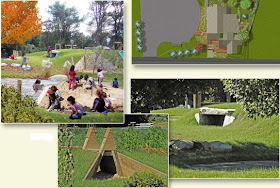
amphitheatre made from natural boulders (though the invasive grasses in my area would make this difficult to tend)

labyrinthine hill

salvaged timber elements

tunnels!
But the best is this cost comparison (from an article by their founder) of what $70,000 buys in a natural playground relative to a commercial 'kit' playground:

from the article: "...spread over this entire area (of the natural playground) is a wonderful blend of about 70 distinct, very different, very wonderful play elements, everything from a rain garden, a labyrinth, an amphitheater, and a large sand play area, to a fairy village, a stream, a teepee village, caves, climbing elements, a slide, fruit trees, benches, a discovery path, and so on. Each one of the blocks of type in the photo represents one of the 70 different design elements.
A landscape contractor estimated $70,000 to build this area.
We decided it would be an interesting exercise to see what $70,000 could buy in the way of equipment. Keep in mind shipping and installation costs are included as are the costs of woodchips (the fall zone material) and the borders to contain the woodchips.
In the top left corner of the photo, you can see what we came up with. This equipment occupies 20% of the entire ½ acre, is visually unappealing, and it’s unnaturally colored metal and plastic is hard and unyielding. Further, the woodchips are a boring, uninteresting backdrop for this crowded little play structure
When the two options are seen side-by-side, other comparisons should be made, as well, such as the number of play elements, the number of children each area can comfortably accommodate, the kinds of activities they can experience by themselves and with others, the varieties of challenges that are available, whether children will be encouraged to think for themselves and make their own decisions about how to play, how much wear and tear will occur on each area, and so on.
Also keep in mind, that dollar-for-dollar, natural play environments offer a much higher "play value" than manufactured playgrounds.
Play value = how many children can be served by one piece of play equipment as compared to its cost. A simple climbing structure that accommodates 6 children might cost $4,000 = low play value. A natural boulder that is part of the landscaping and on which 6 children can climb costs $0 = high play value. Lastly, due to the constant changes in equipment safety regulations, most equipment needs replacing about every 10-12 years!"
Yep I have seen that cost comparison too, interestingly enough however is that they compare the install plus design cost of a "commercial kit" playground to the construction cost of a natural playground (without design cost). That is not to say that the natural playground concept is not way better however it would have been more fair to add design cost into the natural playground as well.
ReplyDeleteExcellent point, Anita, thanks for pointing that out.
ReplyDeleteHi! We would love to include some of the photos of natural playgrounds in a short article on natural playscapes that will appear in our next issue of our newsletter (for the BC First Nations Head Start On-Reserve Program). The author of the article has mentioned your blog and the photos as a source of inspiration for readers.
ReplyDeleteI'm the editor and am wondering if you have any of these photos in higher resolution that would lend themselves better for offset printing.
Thanks!!
Sachiko